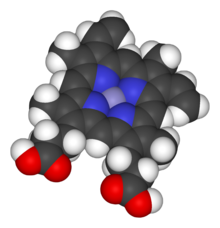Hemoproteins
A hemoprotein is a protein that acts as a ligand to bind heme . Hems are permanently bound to the protein, either covalently , non-covalently or both.
The heme contains a reduced iron atom (Fe 2+ ) in the middle of a highly hydrophobic , flat porphyrin complex. The iron has six possible coordination compounds. The porphyrine ring has four nitrogen atoms that combine with the iron, leaving the two coordination compounds open for connection with the histidine of the protein and a divalent atom.
Hemoproteins probably evolved to take up the iron atom contained in the protporphyrin IX ring of the heme to make it available in proteins. Since this enables hemoproteins to act as connecting partners for molecules with divalent iron, this strategy has been retained in evolution as it plays a crucial role in physiological functions. Oxygen , nitrogen monoxide , carbon monoxide and hydrogen sulfide can bind to the iron atom in hemoproteins. Once these elements have bonded with the porphyrin complex, these molecules can change the activity or functionality of the hemoproteins and also ensure signal transduction . For this purpose, these gaseous molecules are called gasotransmitters .
Due to their diverse biological function, structural and functional characterization, hemoproteins are the most studied group of biomolecules. For the purpose of worldwide analysis of the data on hemoproteins and their structural formulas, these were bundled in one source, the hemoprotein database HPD .
Occurrence and species
Hemoproteins have a variety of biological functions:
Hemoglobin and myoglobin
Hemoglobin and myoglobin are examples of hemoproteins that are necessary for storing and transporting oxygen in mammals . Hemoglobin is a quaternary protein found in red blood cells, while myoglobin is a tertiary protein found in mammalian muscle cells. Although the two proteins differ in location and size, their function is similar. As hemoproteins, both contain a prosthetic group.
